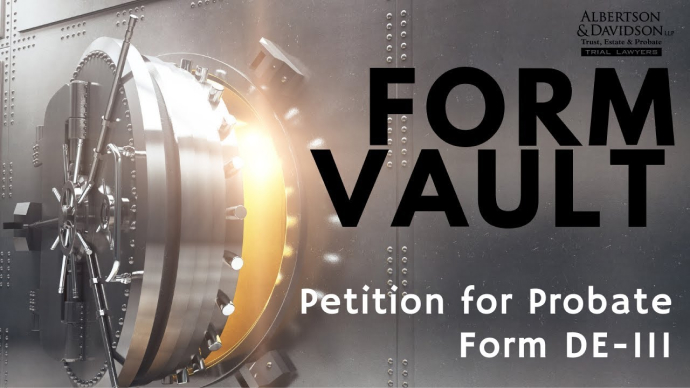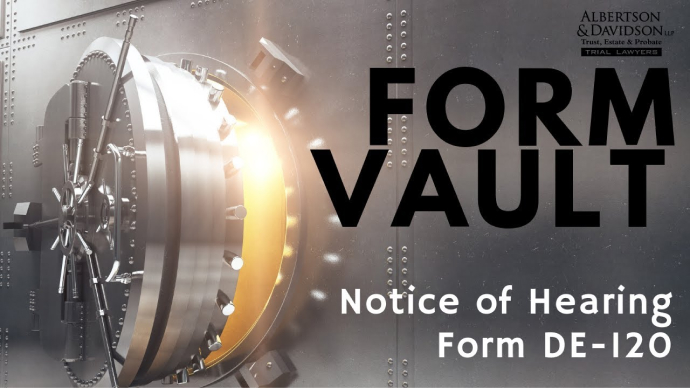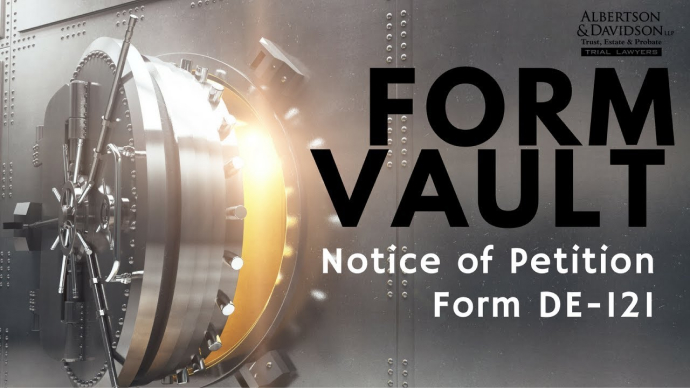Video Transcript
The following is an unedited, verbatim transcript of our video. It is not intended to be a stand-alone article.
Hi, this is Keith Davidson of Albertson & Davidson. In this video, I’m going to go over the forms that you’re going to need notice to creditors of a probate estate. We’ll also discuss the forms that the creditors will ultimately file with the estate if they want to make a claim.
So let’s start off by going to the Judicial Council forms, and I’ll just put that search term into Google and I can pull up the court’s website that have all the Judicial Council forms. There are services that you can find these forms, paid services, but I like to go in this way so you can see that you can get these forms for free, you don’t have to pay for these.
Form DE-157
So we’re going to go down here to Probate, Decedent’s Estates and we’re going to hit C Form. And we’re going to start with form DE-157, this is going to be our Notice of Administration of the Estate. So, we’re going to start off by filling in the name of the estate, and I’m actually having problems typing into this form, it’s supposed to be a fillable PDF but sometimes these forms don’t work that way. So, if you try to type into this and it doesn’t work, all you have to do is go over here to the download button and you can download the form to your computer which I’ve done over here. And now it’s the same form, it looks the same but now we can actually type into the form. And plus once you download it, you can save it in your computer. So we’re going to deal with the estate of Bob Smith. We’re going to start by letting everybody know who the personal representative is. So, we’ll say that he’s wife, Tina Smith, and we’ll put her address, and her telephone number, and we’re saying that this person is a personal representative of the estate of, and again, it’s Bob Smith who is deceased.
And then on number 2, the personal representative has begun administration of the decedent’s estate in the Superior Court County of, so you have to say what county you are in. So if you’re Los Angeles, you’ll just type Los Angeles County, if you in San Diego, in San Mateo, or San Francisco, you just type in the county and then you’re going to put the street address of the courthouse so people know where to send their creditor’s claim because eventually, the creditors are going to have to send notice but also file a claim with the court. So, you’ll fill out all of the case information, and then you’ll have to put in the case number. So I’m just going to make up a case number here, but obviously, you’d put in the proper case number right there. Now you’re telling the creditor, you must file your claim with the clerk with the court clerk addressed in item 2a, so that’s the item that we just addressed, and you must mail or deliver a copy to the personal representative of which would be the address under number 1 before the last to occur the following dates. So there’s timelines that the creditor have, either four months after that the date that Letters were issued to the personal representative. So if Time Smith was appointed the personal representative on October 1, let’s say, then the creditor needs to know that they only have four months after October 1 to file a claim, or 60 days after the date of this notice. And so you have to put the date the Notice was mailed. So let’s say we mailed it on November 1, then that’s the date that you have to put in there. So the creditor will have 60 days after November 1 or 4 months after October 1 to actually file their claim with the court. Those are important deadlines and that’s why you’re sending this is so that the creditor knows those deadlines. The law requires you to notify them of that. And then you have to have a proof of service, so this is where you’re going to say that how you actually serve this on the creditor. And you can fill in your address here, this is where the personal representative lives, and we’ll use the same address that we had up top, you don’t have to if the person serving this live somewhere else or work somewhere else, that’s fine. And then you notice here it says I serve the foregoing Notice of Administration to Creditors, so that’s the form that we’ve just gone over, and a blank Creditor’s Claim form, so you’re supposed to send each creditor a form, a Creditor’s Claim form. In other words, you have to make it easy for the creditors, the law wants the creditors to get the notice and also get the claim form that they have to file to make it very easy for the creditors, and I know that sounds funny but that’s what a personal representative is required to do. And so then they’ll either deposit this notice in a sealed envelope in the United States Postal Service, or you can place it for maling at your place of work if you are familiar with that practice and you know that mail goes out the same day, so you’ll just check out, check one of A or B. If you are putting the envelope into a postbox yourself, then you’ll check 3a, if you’re putting it in your work mail service, you hand it to somebody and that goes off to a mail center at your work, you’ll select 3b. And then you’re going to put the dated that you deposited it into the mail which should be the same as the date that we used above, and where you sent it from, so that they know where you were at when you sent it, and then you’ll date it and you’re going to type in your name, so if Tina is doing this form, it would be Tina Smith. If I was doing this form for Tina, then it’s be my name right here, and I can’t, there you go, and I would just sign it.
And then down here you’re going to put the name and address of each person to whom notice was mailed. So this is where you want to have proof that you mailed this and you’re going to send this out to everybody who is required to get notice in order to show that you did this, you actually notified the creditor. So this is really a pretty simple form, you’re just kind of laying out who the personal representative is, where the court is, where the matter is filed, and some dates that they have to know in order to file their creditor’s claim. And the you mail it. And if you don’t have one of these filed with the court, then the personal representative could be liable for this debt if the creditor never received notice. So that’s the Notice of Administration of Estates.
Form DE-172
Now let’s see what the creditor is going to ile in response to that. So if a creditor receives that, this is then the creditor’s claim. So this is the claim form that the creditor must file if they want to make a claim in the estate, it’s form DE-172. Now the top part here is where the creditor is going to fill in their information. So if again it’s Chase Bank, they’re going to put their address here because they’re the ones who ultimately are making a claim on this estate. And probably, what would happen is it’d be the lawyer for Chase Bank that would file this. But anyway, the creditor would put their name here, you put again the court that we’re dealing with, which in our example we were using Los Angeles County, so we put that, and we put the mailing address right here, and the street address, the mailing address happen to be the same for LA Central District. If your, oops, you’re not supposed to put Los Angeles there, there you go, pay attention to the forms. Alright, so the street address and the mailing address are the same in LA, they’re not the same for every court, some courts will have a different mailing address as opposed to street address. Just look it up, just go to the court’s website, look it up, make sure that you have the right information. Only takes a second to look up that information. And then we’re going to say the Estate of Bob Smith. And don’t forget to put the proper case number. You’ll know the case number because it’ll be on the creditor claim form.
And this is where you are going to give details of the claim. So the total amount of the claim. So if you’re a creditor, you’re going to say “Well, they owe me five thousand dollars”, the claimants name, in this case we’re saying Chase Bank is the claimant and individual or entity doing business under a fictitious name, a partnership, a corporation or other. So in the case, Chase Bank is probably a corporation. The address of the claimant so that we know where to get a hold of that claimant if we need to talk to them or send them payment. And then you’ll have to say whether the claimant is the creditor or a person acting on behalf of the creditor and then claimant is the personal representative. So number 5 is only if the personal representative or the attorney for the personal representative has a claim against the estate. So if your friend owe you money and then they passed away and you just happen to be their executor, and you want to be paid back the money you’re owed, you can make a claim as a personal rep but you have to notify the court that you are making that claim as a personal rep. Here, on our example, Chase Bank is not the personal representative so we just leave number 5 blank.
Number 6, I’m authorized to make this claim which is just and due or may become due. So this is where we want people to say under penalty of perjury that this is a valid claim. And then facts supporting the claim are either on reverse or attached, we’ll get to that in a minute, you almost always want to do an attachment. So you have to state the facts that support your claim, you can’t just say you owe me five thousand dollars, you have to explain why the estate or the decedent owes you five thousand dollars so that the personal representative can evaluate that claim and determine whether they’re going to agree to pay it or not. And the you’re going to put the date, s let’s say they file this on this day, and then the name and title of the person who is filing the claim. So if I was filing it on behalf of Chase Bank, i might put my name and my title, I’m the attorney for Chase Bank, and the I’d sign it and send it in.
This is where you can put the facts. If you want to, you can start here, it’s usually best to use an attachment, don’t even try to use this, but you can, especially is it’s simple. You know, for Chase Bank, they might say “we issued a credit card and at the time of death there was charges or total balance in the amount of five thousand dollars” and that’s all you would need to fill out. If you have a contract, you’d explain the contract, and it’s always a good idea to attach a copy of the contract so that everybody can see exactly why you were owed money. And then you’re going to mail this, you can personally deliver it to the personal representative, but most of the time it’s just mailed. And then we have again another proof of service just like we had on the last form, so the person serving this is going to say their address, they’re going to say the mailed it, they either placed it into a post office box or they put it into their work system for mailing, and it’ll show that it was mailed, addressed and mailed to the personal representative number 1, or personally delivered to the personal representative if the creditor prefers to do that. You can do that either way. And then you’ll sign the declaration at the bottom. This creditor’s claim will be mailed to the personal representative, but up here, this area here if for court filing so you’re also going to file this with the court to make sure that the court knows that you have it as a creditor, have claim against the estate and that claim is going to have to be dealt with before the estate can close.
Form DE-174
So now that we’ve made the claim, let’s look at what the executor does to either accept or reject that claim. And that going to be form DE-174, and so if we go over here to DE-174, this is the Allowance or Rejection of Creditor’s Claim. So this is where a personal representative is either going to look it all, the facts, the paperworks that the creditor submitted, and say “yes, this looks valid, I’m going to pay it”, or the personal representative could say “no, this does not look valid, I’m going to reject it”, or the personal representative could accept it in part and reject it in part, “I’m going to pay a thousand, I’m not going to pay five thousand”.
So we start off by the personal representative, either putting in her own name, and on our example Tina Smith is she represents herself, we would put her name up here. Technically, a personal representative is supposed to have an attorney, but a lot of times people will represent themselves in probate and the court will allow that, otherwise, it would be the attorney’s name. So if I was filing this on behalf of Tina Smith, then I would just put my name up here and my law firm information. And then again you have to put the right court the you’re in and all the various addresses depending on what the court addresses are. And we’re dealing with the estate of Bob Smith and we’re going to put in of course the proper case number so it can get filed in the right area. This is where the personal rep is going to either allow or reject the claim. So, we’re going to put in the name of the creditor, Chase Bank, the claim was filed on November 15th was the example we were using. Date of first issuance of Letters, so the court wants to know was the claim that you’re about to accept or reject, was it timely. Okay, date of notice of Administration, that’s the first form we looked at, and so if you remember, we were serving that on November 1, and the court wants to know whether or not this creditor’s claim came within 60 days of number 4, the date of Notice of Administration. And then you can put the date of decedent’s death, I’ll just keep the first on everything because it makes it easy, and then the estimated value of the estate, this is where the court wants to know are you accepting a claim that can be covered by this estate, or is the claim just too big. A total amount of our claim that we’re dealing with is $5,000.00, and then the personal rep can either, the claim is allowed for, so example the claim is allowed for $5,000.00, you’re just going to accept all of it, or you can say that the claim is rejected for $5,000.00, in which case you wouldn’t put anything here, so you’re just going to reject all of it, or you can do any combination, so you can say it’s allowed for $2,000.00 but it’s rejected for $3,000.00, so you can allow it and reject part of it. And then you have to say the date of the Notice of rejection is given, and then the personal rep is authorized to administer under the Independent Administration of Estates Act. The court just wants to know whether or not the personal rep has independent powers. So if so, check that box, if not, don’t check that box. You’ll know if this is the case because if you go back and look at the Letters of Administration, it’ll tell you whether independent powers were granted, so just go ahead and click that box if it is. And then we’re going to put the date that we’re doing this allowance in rejection , and then we’re going to put the name of the personal rep which is Tina Smith, and then Tina’s going to sign this. Now, there’s certain claims that the court must approve or reject, so any claims against the personal representative or any claims that are submitted by an attorney for the personal representative, have to be approved or rejected by the court. And so, that’s what this is about down here.
And then of course we have our proof of mailing or or personal delivery, and we’ve been over this a couple of times now, and so you’re just going to say that I mailed it to the creditor, and again you deposited it in an actual post office box, or you place it in your work’s mailing system. And then you’re going to put in the name of the creditor that you served and you’re going to put the address on the envelope, the date of mailing, the place of mailing, or you’re going to personally deliver it to that creditor. One way or the other, the creditor must receive notice of this allowance or rejection because the creditor may have to take action if you reject their claim. And then you’re just going to date it and sign it, whoever serves this.
This whole process of notifying creditors, having creditors submit a claim, and then either allowing or rejecting that claim, it’s a very important part of probate because until the creditors claims are dealt with, you can’t close up the estate, you can’t distribute any of the assets out to the beneficiaries, all of these has to be taken care of first. So it’s really important to get these notices out to creditors as soon as possible once a personal representative is appointed, and it’s important to pay attention to which creditors choose to file a claim, and then it’s important that the personal representative decide fairly quickly whether or not they’re going to pay that claim. So in our example, if Chase Bank was going to be pad the whole five thousand, for example, and none of it was going to be rejected, then that creditor knows that they don’t really need to do anything, their claim has been accepted and they’re going to get payment before the estate closes. If their $5,000.00 claim wa rejected for any reason, then they’re going to have to file a lawsuit within the 90 days of receiving that rejection. So it’s very important that the creditor know that so that they can take action. And the personal representative is going to be held liable if they don’t give these proper notices out because they could be doing harm to the creditors if they don’t handle these things properly. So it’s very important for a personal rep to take these notices to creditors seriously and to make sure that they’re served properly.




